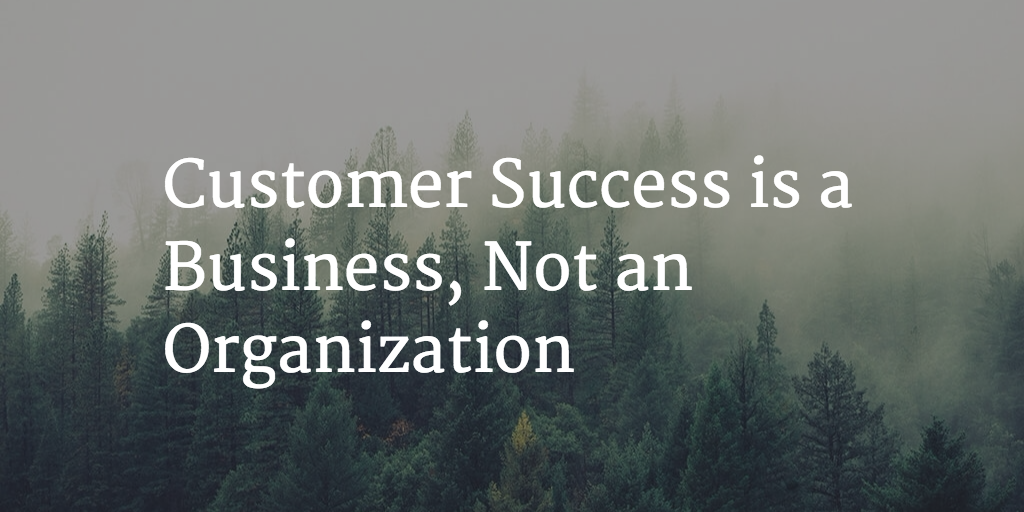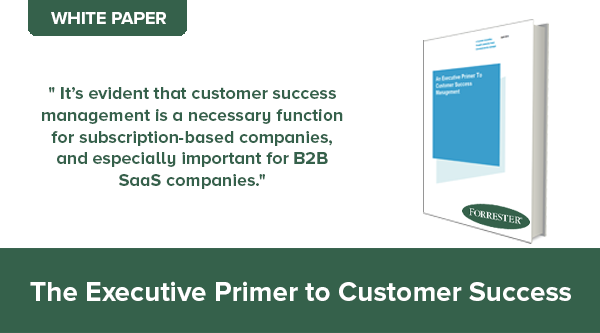We’ve spent a lot of time and energy in the past couple years helping to provide some insights and best practices into the practitioner side of Customer Success Management. We’ve had lots of discussions about how to hire and compensate CSMs, how to score customer health, how to manage your RED/Yellow/Green meetings and many, many more similar subjects. Those are good and highly valuable conversations but we’ve never really talked about the business side of Customer Success.
Let’s change that right now.
Customer Success Drives Revenue
It’s been my contention from Day 1, and I’ve talked to many of you directly about it, that Customer Success is a revenue-driver, not a cost center. And anyone building a Customer Success organization must do everything they can to position it that way.
Cost centers are always subject to cost cutting while revenue-driving teams have higher visibility and provide greater protection from the downs of a business while reaping the rewards of the ups. In order to do that, Customer Success needs to be a clear and justifiable investment.
And, by “justifiable”, I mean “driving incremental revenue growth”.
Customer Success is All About Growth
Customer Success’ job, generally stated, is to grow the install base. That happens as a result of two things – 1) High renewal rates, and 2) Customers buying more product. But renewal rates and growth of the install base are only half of the equation if you are running a business. The other half is, of course, cost. A 100% renewal rate is certainly doable if you have unlimited resources. 120% net retention is where the very best companies land. But, how much do they spend to get there?
In order to understand the business, you need to know both the numerator and the denominator. It’s no different than trying to understand someone’s gas mileage based on how many gallons of gas they put in their tank the last time they filled up. It’s not enough information.
So, what makes up the cost part of the equation? Obviously, people are the biggest factor. In reality, you could probably do a very good analysis if that was the only cost you considered. Otherwise, you need to go all the way and figure out the cost allocation for all organizations that support Customer Success – like Finance, HR, Engineering, etc. Unless you are a wholly owned subsidiary or the GM of an independent business unit, that level of detail is not worth gathering.
Costs of Customer Success
My suggestion is to use only those cost elements that are directly and exclusively allocated to Customer Success and Renewals:
- Customer Success team
- Renewals team (if separate)
- Software used only by either team (not CRM which is used by everyone)
- Upsell team (if different than the Customer Success and Renewals teams and upsell is going to be included in the retention numbers)
Remember, the important thing here is going to be the trend, not the actual profitability number, so every cost does not have to be included. In other words, there’s no need to go figure out what the proper cost allocation of Salesforce.com is to the Customer Success team. Just count what is exclusive to your world and stay consistent as you track it over time.
Customer Success ROI
Now let’s plug in some numbers and see what we can figure out. Let’s say you have a business with $50M of Annual Recurring Revenue (ARR) and you subscribe to something close to Jason Lemkin’s suggestion of one CSM for every $2M of ARR so you have 20 people on the team. Now let’s say the fully burdened cost of the team averages out to $150K per head and that you are spending another $200K on software specifically for the Renewals/Customer Success team. That’s a total cost of $3.2M against an ARR of $50M meaning that your costs are 6.4% of the ARR.
More useful than just knowing that number would be seeing a moving average of that number over several months. This could be the number (preferably a range or a ceiling) that guides your decisions around adding headcount, increasing your non people-related expenses, etc.
At this point, I’d spend time trying to map this number out historically and involve my Finance team in doing so. Eventually you’ll want to get agreement, probably from your CFO, with regard to what the “right” number is. Is 6.4% good or bad? This might vary based on the type of business you are in but I think there are general guidelines that will make sense. My experience says that anything under 10% in a SaaS company is definitely not over-investing and I think our experience over the next few years will show us that you can take that number to 20% and still easily justify the investment.
Now, let’s go a step further and look at what happens if you add more investment. For ease of discussion, let’s assume the net retention for this company is exactly 100%. So, you started the year with $50M of contracts and you ended the year with $50M of contracts from those same customers. Some churned and some had downsell, but you made up for that with commensurate upsell. While you were preserving that $50M, your Sales team was adding another $30M to the ARR so the overall install base value is up to $80M.
There are Two Ways to Grow
Now, your CEO issues the challenge to the executive team to increase ARR by an additional $8M next year. There are only two ways to do that – increase new business sales by $8M or get $8M more from your install base (or some combination).
Your aggressive VP of Sales steps up and says he can add $8M with 10 people ($1M quota each at 80% average performance). Those 10 Sales Reps will cost the company $2M at $200K each after commissions. On top of that, you’ll have acquisition costs to feed the Sales team. If your time-to-recover CAC is, say, 18 months (pretty standard), you’ll have to add another $3M of acquisition costs to your total costs to get the incremental $8M. Is $5M to get another $8M a good deal? Obviously, that depends on a lot of things and may be a different answer for every company.
But now’s the time to be a Customer Success superhero. You are currently driving $2.5M of ARR for each member of your team. Let’s say going from 100% to 110% net retention is harder than maintaining 100%. That’s logical and almost certainly true. So let’s agree that you can only do $2M incremental per person on top of the ARR you are already driving, which means you need four more people.
Now build in a little cushion and go up to five people, or $750K, and you are still only 15% of the cost required to accomplish the same goal with Sales people. You may even be able to do it with only three or four people plus an additional $100K in software investment. That’s even better.
Here’s what is really interesting. Let’s say your CFO agrees that spending $64 for every $1000 of renewals is a very good ratio (that’s the 6.4% we talked about earlier). That theoretically allows you to hire 12 more people to manage the additional $30M of ARR your Sales team delivered. And now, with the addition of the five people to drive the incremental $8M of ARR that your CEO wanted, you are now at $5.95M of cost against $88M of ARR, which is a 6.8% cost ratio. If you execute, you will deliver an additional $8M of ARR at a cost that is 1/6 of what it would have cost to do it with Sales people and you’ve moved your cost ratio up by a mere 3/10 of 1%.
The Business of Customer Success is Booming
The bottom line is this – if you are running Customer Success as a business, you will understand your leverage and can make these trade-offs and decisions. And this is the kind of contribution and thinking that gives Customer Success a seat at the table. That’s the table where big decisions are made and companies break through their projected growth rates on their way to much bigger numbers. And the people who make that happen get rewarded in a major way.
Now’s the time to start thinking big, and outside the old box which includes things like churn, retention, and customer sat. Those are all important but if we are to elevate Customer Success into the business conversation (strategic, not just tactical), we need to think and talk like we are already at the big boys’ table.
You run a major revenue-driving organization and you may well own the biggest chunk of your company’s ARR. That gives you a great opportunity to impact the growth and success of your company, not just your NPS score. And most importantly, you are the most cost-efficient way to drive incremental ARR. Take advantage of that for yourself and for your company. Carpe diem.
I encourage you to download and read all of Forrester’s findings on Customer Success – including the process they used to determine their findings – by downloading “An Executive Primer to Customer Success Management” right now.


